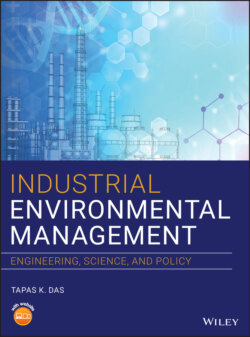Читать книгу Industrial Environmental Management - Tapas K. Das - Страница 45
1.11.5.1 System Design
ОглавлениеDaimlerChrysler put in operation ZLD systems of two kinds. The first uses reverse osmosis (RO) to produce a concentrate of total dissolved solids (TDS), which is sent to a large evaporator and eventually on to a lagoon or solar evaporator pond. Used in dry, arid areas of low elevation, this system is frequently found in the WWTPs of Northern Mexico's automotive facilities. The other system, used at the Toluca facility, softens and removes silica from the RO concentrate through microfiltration before sending the water on to another RO unit where it is further concentrated. Water is then returned and blended with the water from the first stage water, where the concentrate is sent on to either an evaporator or a crystallizer to dry TDS to powder and eliminate the need to dispose of liquid.
In essence, industrial plants with ZLD installations can expect to recover nearly 100% of water that would otherwise be discharged to the environment as wastewater. At the Toluca facility, the WWTP recovers 95% or more of the water used for processing, with a recovery rate of up to 237 500 gallons per day (gpd). In actuality, the ZLD installation at the Toluca facility is two separate systems: a sanitary water system that biologically treats wastewater from the complex's restrooms, showers, cafeterias, and other domestic areas, and a manufacturing‐process water system that chemically treats wastewater mixed with heavy metals and paint from the assembly plant. The latter also treats wastewater containing emulsified and soluble oils from the facility's stamping, transmission, and engine plants.
In the sanitary water system, domestic water is collected and sent through a screening mechanism before moving on to the biological treatment system's equalization tank, ensuring a constant, even flow of water through the system. This water is then passed through jet aeration sequential batch reactors that treat the water with microorganisms and air to reduce the biological oxygen demand (BOD) and chemical oxygen demands (COD), as well as suspended solids. The complex uses the 150 000–200 000 gpd of disinfected water to irrigate its landscape. The microorganisms and solids recovered from the batch reactors are then sent through a sludge digester and eventually a filter press that eliminates the water. While the dewatered sludge is used as fertilizer, the filtered water re‐enters the system.
Wastewater from the Toluca facility's three machining plants is directed through the manufacturing‐process system where it is first chemically treated, passing through a filtering screen. In a separate tank, chemicals are used to de‐emulsify the free‐floating oils that comprise most of the waste. Afterward, the oils are removed and stored in another tank before disposal. The process water from the machining plants is then mixed with water from the assembly plant that contains residue from the spray painting, phosphating, E‐coating, and body‐wash operations. Upon being mixed with a combination of ferric chloride, lime and magnesium oxide, metal pollutants and silica are rendered insoluble and turned into sludge that is removed and sent to a landfill. Then, to further lower the proportion of unwanted organic compounds, the water is pumped to a biological system that reduces the BOD to 20–30 ppm.
